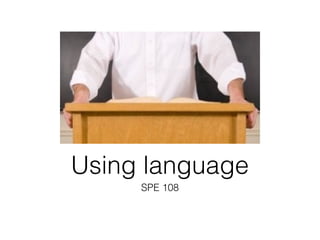
Using Language
- 2. Meanings of words Words have two types of meanings: denotative and connotative • Denotative meaning : precise, literal and objective • Connotative meaning: more variable, figurative and subjective • What do you think of when you hear the word "school?" Is your reaction positive? Negative? Nostalgic? Hopeful? This is an example of a word's connotation • Connotative meaning gives words their emotional power and intensity
- 3. Using language accurately Criminal persecution or criminal prosecution? [these words are spelled similarly, and have a similar pronunciation -- could be easily mixed up – but what about their meaning? Similar or different?] •Errors in use of language can make the speaker appear poorly qualified, ignorant or unprepared. •A thesaurus can be a valuable tool for finding just the right word, with the right connotation.
- 4. Using language clearly • You cannot assume what's clear to you is clear to the audience • A speaker's meaning must be immediately comprehensible • Use familiar words: unless you have an audience that specializes in your topic, you will make a clearer communication effort using ordinary language • Ordinary language does NOT mean you cannot be descriptive and vivid
- 5. Using language clearly • Choose concrete words: words that refer to tangible things (like carrot, pencil, nose, versus words like philosophy, science, humility - these are abstract words) • Eliminate clutter: clutter happens when you use more words than necessary to express an idea
- 6. Using language vividly • Just as you can be accurate, without being clear -- you can be both accurate and clear without being interesting • If you want to move people with your speeches, use vivid, animated language
- 7. Using language vividly Imagery: creating word "pictures" that allow the listener to "see" what you're describing • Concrete words: enhance clarity, as well as being the key to effective imagery. They call up mental impressions of sights, sounds, touch, smell and taste. • Simile: an explicit comparison between things that are essentially different, yet, have something in common. It always has the words "like" or "as."
- 8. Using language vividly • Cliches: overused phrases. Fresh as a daisy. • Metaphor: an implicit comparison between two things that are essentially different yet have something in common. Does not contain like or as.
- 9. Using language vividly Rhythm: the pattern of sound in a speech created by the choice and arrangement of words. • A speech, however, is not a poem. You should never emphasize rhythm at the expense of meaning.
- 10. Using language vividly • Parallelism: the similar arrangement of a pair or series of related words, phrases or sentences. • Repetition: reiterating the same word or set of words at the beginning or end of successive clauses or sentences. • Alliteration: repetition of the initial consonant sound of close or adjoining words. • Antithesis: the juxtaposition of contrasting ideas, usually in parallel structure.
- 11. Using language appropriately In addition to being accurate, clear and vivid, language should be appropriate -- to the occasion, to the audience, to the topic and to the speaker. • Appropriateness for the occasion : a coach may address a team as "you guys." would this be appropriate at a formal speaking engagement? • Appropriateness to the audience : avoid off-color language, speak at the appropriate level for the audience. Err on the side of caution.
- 12. Using language appropriately • Appropriateness to the topic : certain topics require a more straightforward delivery, whereas other tropics lend themselves well to utilization of imagery, metaphor, simile, etc. • Appropriateness to the speaker : in the beginning, you are developing a style as a public speaker. Practice techniques, but do not try to "become" someone else when you speak.
- 13. Inclusive language Inclusive language: the use of language which is respectful of the different diverse groups that make up American society
- 14. Notes on inclusive language 1. Avoid the generic "he" 2. Avoid the use of "man" when referring to both men and women. 3. Avoid stereotyping jobs and social roles by gender 4. Use names that groups use to identify themselves.
